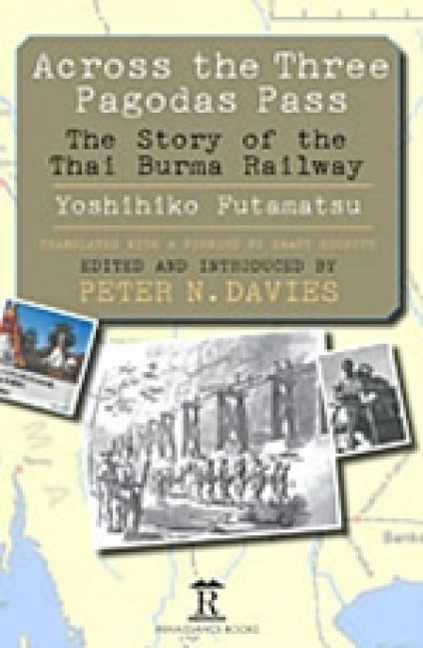Book contents
- Frontmatter
- Dedication
- Contents
- Acknowledgements
- Foreword
- Introduction
- Across the Three Pagodas Pass
- Translator’s Acknowledgements
- Preface
- Chapter 1 Departure for the Front
- Chapter 2 In Indo-China
- Chapter 3 Opening of Hostilities
- Chapter 4 The River Krian
- Chapter 5 The Malayan Campaign
- Chapter 6 The Fall of Singapore
- Chapter 7 Surrender
- Chapter 8 Shōnan: Light of the South
- Chapter 9 The Thai-Burma Railway
- Chapter 10 Preparing Construction
- Chapter 11 Banpong
- Chapter 12 Prisoners-of-War
- Chapter 13 Constructing the Railway
- Chapter 14 Thailand
- Chapter 15 The River Kwae Noi
- Chapter 16 The Mae Khlaung Bridge
- Chapter 17 Kanchanaburi
- Chapter 18 The Jungle
- Chapter 19 From Bangkok to Singapore
- Chapter 20 Rush Construction
- Chapter 21 The Base at Wanyai
- Chapter 22 The Labour Force
- Chapter 23 Survey Unit
- Chapter 24 Test Run
- Chapter 25 Bridge-Building and Shifting Earth
- Chapter 26 The Rainy Season: The Monsoon
- Chapter 27 Kinsaiyok
- Chapter 28 Diseases and Epidemics
- Chapter 29 Cattle Drive
- Chapter 30 Living in the Jungle
- Chapter 31 Soon to the Three Pagodas Pass
- Chapter 32 Towards the Setting Sun
- Chapter 33 Opening to Traffic
- Chapter 34 The Bombing
- Chapter 35 End of the War
- Chapter 36 Internment
- Chapter 37 Repatriation
- Footnote
- Postscript
- End Notes
- Glossary
- Bibliography
- Index
Chapter 22 - The Labour Force
Published online by Cambridge University Press: 13 May 2022
- Frontmatter
- Dedication
- Contents
- Acknowledgements
- Foreword
- Introduction
- Across the Three Pagodas Pass
- Translator’s Acknowledgements
- Preface
- Chapter 1 Departure for the Front
- Chapter 2 In Indo-China
- Chapter 3 Opening of Hostilities
- Chapter 4 The River Krian
- Chapter 5 The Malayan Campaign
- Chapter 6 The Fall of Singapore
- Chapter 7 Surrender
- Chapter 8 Shōnan: Light of the South
- Chapter 9 The Thai-Burma Railway
- Chapter 10 Preparing Construction
- Chapter 11 Banpong
- Chapter 12 Prisoners-of-War
- Chapter 13 Constructing the Railway
- Chapter 14 Thailand
- Chapter 15 The River Kwae Noi
- Chapter 16 The Mae Khlaung Bridge
- Chapter 17 Kanchanaburi
- Chapter 18 The Jungle
- Chapter 19 From Bangkok to Singapore
- Chapter 20 Rush Construction
- Chapter 21 The Base at Wanyai
- Chapter 22 The Labour Force
- Chapter 23 Survey Unit
- Chapter 24 Test Run
- Chapter 25 Bridge-Building and Shifting Earth
- Chapter 26 The Rainy Season: The Monsoon
- Chapter 27 Kinsaiyok
- Chapter 28 Diseases and Epidemics
- Chapter 29 Cattle Drive
- Chapter 30 Living in the Jungle
- Chapter 31 Soon to the Three Pagodas Pass
- Chapter 32 Towards the Setting Sun
- Chapter 33 Opening to Traffic
- Chapter 34 The Bombing
- Chapter 35 End of the War
- Chapter 36 Internment
- Chapter 37 Repatriation
- Footnote
- Postscript
- End Notes
- Glossary
- Bibliography
- Index
Summary
In an investigation pre-war at IJA GHQ it had been estimated that two railway regiments could build a railway linking Thailand to Burma in one year, but careful thought was not given to what mechanical gear might be needed. Accordingly, in practice, labour for roadbed construction was assumed to depend on human effort. In March 1942, under Southern Army's 2 Railway Control, from the start it was assumed that a human labour force would do it. From topographical maps the earth-work of roadbed construction on which the railtrack could be laid was estimated to total at least 15 million cubic metres of earthwork, and bridge-building a distance of upwards of 30 km. The period of construction was estimated as two years and the number of labourers needed was assessed as over 25,000 each day. On the fall of Singapore, in the Malayan battle-area and the successful occupation of Java and Sumatra, the prisoners-of-war of British, Dutch and Australian nationality were numbered in March 1942 as around 100,000, and they were mostly in prison-camps at Changi on Singapore Island. For the Japanese Southern Army it was in the natural order of events that, as these men were still alive, that they were seen as the labour force for constructing the railway. However, one does not know whether it was an infringement of the Geneva Convention International Pact on Treatment of Prisoners-of-War because Japan did not ratify it. The British and American Governments started the war so whether their action was against the Japanese Government's diplomatic stance and whether Southern Army really understood the situation and were well-informed or not one does not know. However that may be, in Southern Army's plan it was stated that prisoners-of-war and locally conscripted coolies would be used as the labour force.
As a result of the survey mentioned in Chapter 9 it was forecast that the volume of work required was greater than had been forecast in 1939, but by January 1943 it became strategically essential to demand that the time-scale should be shortened, to be effected by rush-construction, and that work force had to be augmented.
- Type
- Chapter
- Information
- Across the Three Pagodas PassThe Story of the Thai-Burma Railway, pp. 106 - 110Publisher: Amsterdam University PressPrint publication year: 2013



